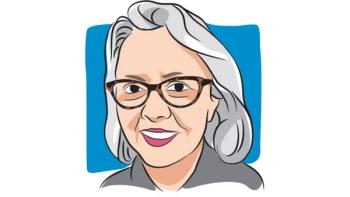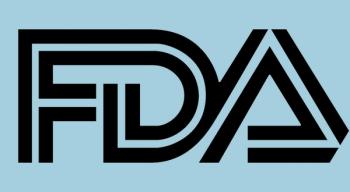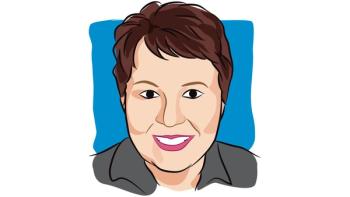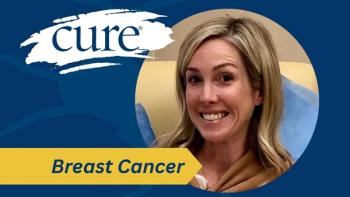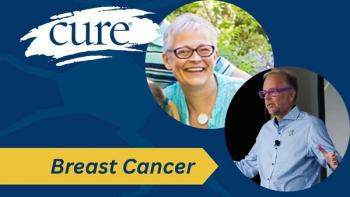
Answering Your Patient Navigation Questions
We answer your patient navigation questions at the 4th Annual Patient Navigation Town Hall "Empowering and Mobilizing Our Patient Navigation Workforce".
Hi, my name is Kristie Kahl, editorial director of CURE magazine, the indispensable guide to every stage of the cancer experience. It's my pleasure to be joined with Dr. Klemp today, so that we can kind of recap what everybody has talked about today and kind of go over the highlights that everybody's learned. So, before we get into some of my questions, Jennifer, we actually have a question from the audience that says, I am a nurse practitioner leading a breast cancer navigation program. I would love your input and experience of advanced care providers taking on navigation roles with regards to care and reimbursement.
Klemp: So that question is a great question. And I think it's important to think about advancing APP roles in general. And as I think about an APP and their need, not really to sub specialize, but to have those concentrations that bring uniqueness to their role, whether it be navigation, whether it be genetics, or survivorship. They're really wasting To strengthen that expertise, and I think navigation because it is built in as an integral part to a lot of the alternative payment models, and so much of where we're going and healthcare, then I think that that can be a real advantage to taking on some of those roles, because the HPP is a billable provider. And so by taking the reimbursable pieces that are embedded with the navigation that right now, we don't get paid for. I think that that could be a real strength and advantage to the organization and to the patients that your survey.
Right, yeah. And so I kind of want to go back a little bit to this morning. So Dr. Gorgon had mentioned that there were four things that we've learned from COVID so far. So what do you think is the one of the main aspects that we've learned from COVID as patient navigators?
So Dr. Gorgan had a lot of insight and I think the thing that, you know, when I wrote in took my notes from him his talk, a lot of it obviously was about the power of transmission and a lot about sort of where we need to rapidly go. Based on the fact that this is a unique and pretty aggressive virus that we're dealing with. It's unlike others that have come before it. So I think the part that was important for navigation to take out of that, is that geographically where we do see these differences, whether it's what we see in the northeast or the southeast, which are different and different peaks in the end, when we are seeing exposures and preparing for kind of this next round. I think the important part for navigators is that pay attention to what we've just done. Let's learn from what worked and start preparing in our conversations for these potential next waves. Because the reinforcement, the expectation management for both ourselves, our staff and out patients will really be helpful as this does not seem to be something that's going to stop tomorrow. It's going to have a prolonged life. And let's use the lessons learned to help empower us for the next wave.
Definitely. And so you know, in cancer, we talk with a lot of patients and caregivers about the fact that a cancer diagnosis can be this new normal. But you know, with the pandemic, I think we are all facing a new normal now across the nation. And you know, and in Karen, Linda and Donna's talk that they had earlier this morning as well, they mentioned ways to kind of implement different strategies into their daily practice and how that's changed for them. So what are you hoping are the key takeaways for navigators to take away from this new reality so that they can start implementing different strategies into their day to day?
Yeah, I really liked that session and I felt like we had a lot of great insight from pretty innovative people that are also practical, right? You need innovation and practicality together to really make some solutions. So, I think we need to some of the lessons from Karen that I took away, we need to be surveying really our teams as well as our patients to what they can and can't do. Are they prepared or not prepared and address those lingering issues? technology is new for a majority of our patients in this capacity. So how do we build those kind of quick start guides and help them whether it's a you know, minute and a half YouTube video that their grandkid can help show them? You know, how do we help them leverage technology because that's not going away?
And then how do we really continue to provide professional education and push in a bidirectional really sort of conversation? What is needed? And then how do we push that perfect All education out to the field. And there really needs to be an ongoing not only repository, but ability to have that real time what you need to know, kind of conversation that happens every day and is relevant not here's the update for today. But here's what you need to know to help you do your job today.
I know you and Nicholas had also mentioned the fact that compassion fatigue and burnout is very real. And I can only imagine that during the pandemic, it's even more real than usual. So how can the navigation tool and the Academy of medicines toolkit address this navigator fatigue and burnout?
I think one of the biggest things it can do is brings organizational awareness. Right. So I think that, you know, a lot of times people will talk about issues they don't necessarily embrace or understand what the full scope of that is, in our town halls. I know at the University of Kansas Cancer Center. Some of our leadership have been pretty candid with the challenges they've had.
So that personalization, which we don't use very often you kind of use it sparingly as needed, but kind of PRN, that personalization would be really helpful, because how do you get the organization on board, which needs to support the staff and the people working from home and the people who are coming in and exposing themselves and their families. So, I think that if nothing else, we need more organizational awareness. And I'm hoping that some of those tools can really bring the evidence that's required for organizations to see this as a problem and to hopefully support not just by acknowledgment, but in action of preventing compassion, fatigue and burnout.
I know Nancy and spoke earlier about technology. So with that, how far would you say we've come with technology and breast cancer care? And what do we have to look forward to as patient navigators?
Technology has accelerated like a rocket ship, right? So I've seen organizations that had like 18 to 24 month plans, deploy them in two weeks. So it has been, you know, trial by fire. So the reality is, that's not going away. And I think that we need to number one, really streamline our utilization of technology. I am burnt out in the sense of being on zoom for like seven hours a day. So that's not you know, that's not healthy either. So we need to figure out that the balance of of using technology, we need to figure out the security of technology. We need to empower our our aging workforce in oncology. Aging, that's relative, but the fact is, is that not everybody is good with technology. So how do we kind of streamline some of the onboarding and quickstart so that people don't feel so overwhelmed and shut down, or the workforce we do have says, to heck with this, I'm done. I can't do anything. This is just, it's too much, which is also happening.
So, I think technology can help us. It also, though, has caused part of the epidemic, right? There's so much information, where do we go? How do we know that it's reliable? We did a cancer and COVID echo series in April, and one of the sessions we covered the infodemic of COVID. And that, you know, there's 700% increases, in fact checking, you know, so much is happening, but how does an average person or an average healthcare worker, keep up with what they should or shouldn't know. So I think we need to develop some some digestible information that is reliable because just you Too much out there. So technology overload is a concern. But technology is essential. So we need to do a cost benefit, kind of get the teeter totter back in check, and figure out how to support the workforce and our patients as we continue to to utilize technology, more and more.
Right, definitely. So, we actually have another question from the audience. Dr. Klemp, what influenced you to go into patient navigation? And what would you suggest to people who are considering going into this field?
I’m, by trade, and not a navigator I function in a role of supporting navigation and have navigated and have had hired navigators. So I'm like I'm, I grown in the process. But I will tell you a funny story, which I normally don't I don't normally personalize. But my mother was diagnosed with breast cancer back in 1984 when I was graduating from college and going to med school, and the interesting part is that she He was one of those people who had a bone marrow transplant for her breast cancer. So, I have lived through that. And I was her personal, you know, caregiver who took off time and, and that was my ROI is being with my mom. So when I was done with the acute part of the journey, I wrote my mentor of breast medical oncologist aka letter, and I described the role of a navigator, she still has this letter, and I described it to the tee, it didn't exist at that time. But I said, this is what we need for patients going through this intense type of journey.
And it wasn't just for transplant, it was just cancer in general. And so, you know, I disclaimed multiple times that I play one on TV so I have not playing a navigator on TV, but I have been in oncology for 25 years, filling a lot of those roles and supporting that need, and hired one of the first survivorship navigators in the country back in the mid 2000s. So I think that the important part about what motivates us to either fill a role support a role, or be part of that team is that I do believe in team medicine and team science. And I believe that navigation, if any of you've ever seen the continuum of care map that I use as integral as part of my philosophy, navigation is the first piece and it continues through the entire cancer journey. So, you know, I would like to say that that navigation is a core of my philosophy, and that it's part of what I believe is how we achieve really better outcomes, better patient care and better quality and quantity of life for our patients living with cancer.
So, I want to shift gears back a little bit from the session this morning, how we can become a whole so Dr. Newman to discuss the racial disparities to having a Access to cancer care? How can we work to negate these disparities and help patients, you know, navigate their care? And moreover, are there any resources that we can offer to help bridge this gap?
Dr. Newman did a very beautiful job even using some analogies like the Titanic and showing, you know, access to care and those barriers that we need to tackle. We also on the flip side of that conversation had the CDC sitting there with programs like the early detection works in screening breast cancer, breast cancer and cervical cancer screening programs.
Most of the states that I interact with are underutilizing those types of screening programs. So how do we empower our local safety net clinics or community providers primary care, to know about how to use some of those programs to get patients in for screening, my colleagues and I in Kansas are working on developing a program not only to empower Local primary care, local family practice and our safety net clinics and our early detection work clinics is what we call it. But how do they utilize risk stratified screening? So, when do they start screening?
How often do they screen because there are so some conflicting messaging, depending on if you're getting screening recommendations from your professional organization, or from the US Preventive Task Force. So, I think the important part is that we need to better utilize existing programs, we need to identify where those gaps are and where the limitations are. And I think navigation can really help us fill in those gaps. But I always hate to build new things until we fully utilize the existing programs and services that we have. And I do think that many of those are underutilized because people don't know about them. People don't know how to access them, and they don't know how to use a lot of those programs that are out there.
And so during that same session, Dr. Farley had discussed, you know, integrating community health workers and navigators into the plan of care. So, up here we talk a lot about the multidisciplinary approach. So how can we help patient navigators make sure that they're integrating themselves into the multidisciplinary approach to cancer care.
I think that from that, that first touch point of the community health worker being in the community, they can match patients to those resources. They can be the conduit that a busy primary care or safety net clinic who doesn't navigate that process, well, they have a resource to help them help their patients access that resource. I think that that by us, utilizing community health workers to understand and maximize those opportunities to have us as providers be able to pull those types of individuals into our seminars, our discussions and our trainings would be ideal because then you're Bringing, like you talked about that multidisciplinary approach. But the circle of care has to all be informed and know how to communicate as well. And if we don't sort of foster the circle of care, then it will always be fragmented.
So, I think we need to, to bring in that entire, you know, family that's caring for that patient into the picture before we're going to really be able to maximize and leverage all those existing resources.
What do you think is next and where do we go from here for patient navigators?
I think in kind of summarizing the themes for today, there's some common threads, obviously, of education, scope of practice, the lanes that are filled, but there's also the need to come together to have these discussions to continue the conversation, because there are going to be speed bumps in the road, right?
So, we're going to lane with the speed bumps occur. And that could be COVID-19. It could be changes in someone's insurance status. There's lots of barriers that happen. And we have to be able to pivot as a healthcare delivery system as patients. And so, my two biggest sort of common themes that I took away from today are that we need to be better at having expectation management being sort of transparent with roles, responsibilities, expectations.
Then the other part of that is we do need to work on how we communicate and utilize that team and those resources. So, expectations, priorities, transparency, and then leveraging what's currently there, so that we can identify those gaps and then work towards that common goal of standards. accreditation reimbursement, which is really the next tier up, we have to kind of continue working on this tier before we can go to the next year. I think that we have a lot of work to do. But we have a lot of key stakeholders and bringing them together.

